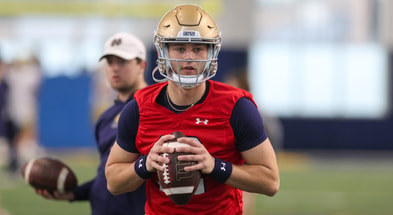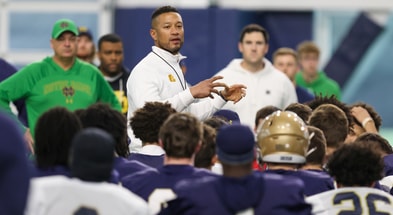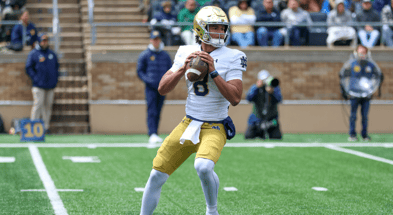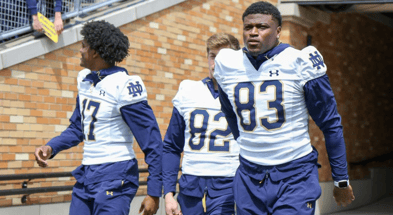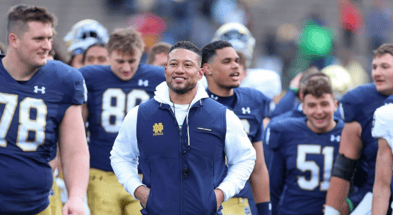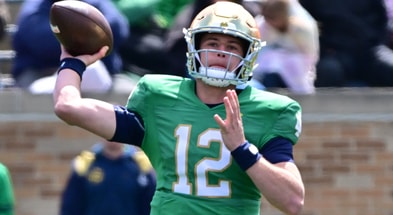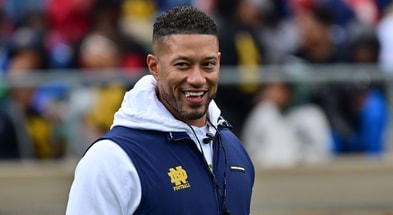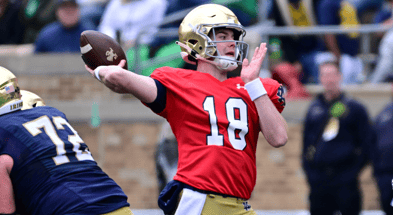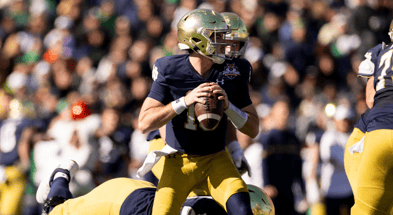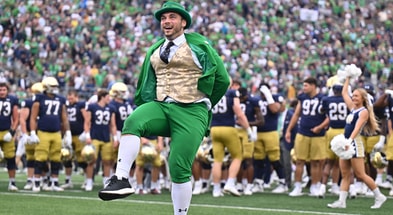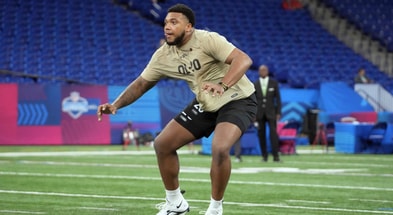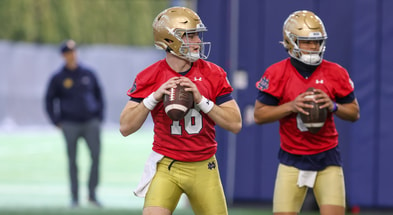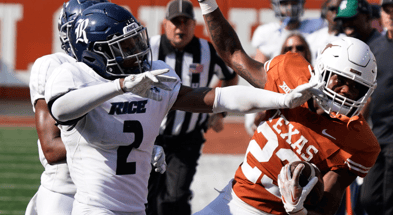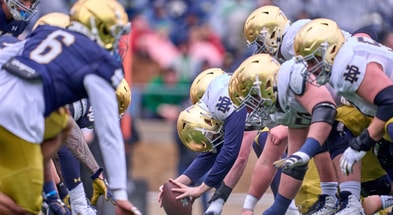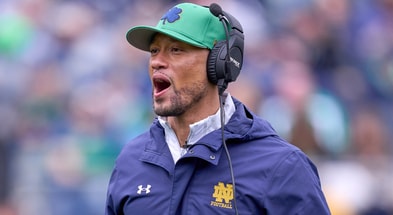Notre Dame can play the long game as it decides its next course in latest realignment wave
The latest collision of college athletics’ tectonic plates has led to widespread anxiousness around the idea of a Notre Dame-triggered aftershock. As the dust settles on USC and UCLA’s June 30 bolt to the Big Ten (and resulting knife wound to the Pac-12), attention has shifted to speculation about the Irish’s next move. All eyes are on Northern Indiana.
Maybe Notre Dame’s next move will spark another tremor across a sport that’s racing toward a new model. Maybe it will (temporarily) calm the waters. Who knows. But everyone wants to know – soon. It feels like the entire country wants to poke Notre Dame with a stick in a collective plea of, ‘Well, do something!’
The bubbling suspense makes one wonder how long it truly can afford wait and plot it next steps. Sports Illustrated’s Pat Forde reported Monday the timeline for a final decision is wide. It could be “in a week, or six months, or a year from now. We don’t know,” an industry insider told Forde.
PROMOTION: Sign up for just $1 for your first year at Blue & Gold
The waiting with bated breath will continue. But what’s clear now is this: If the preference is independence – as Forde reported– then Notre Dame owes itself a thorough and complete examination of feasibility in whatever college sports looks like going forward.
The Big Ten’s expansion west alters the meaning and the math of joining a conference, but it doesn’t change Notre Dame’s three key pillars of independence: an accessible championship path, a home for its non-football sports and a television partner.
Will all three remain in this next era of college sports? Hard to say. Radical change hardly seems finished. Notre Dame athletic director Jack Swarbrick even said as much in April. Combine the uncertainty with the larger-than-ever cost of independence trade-off, and it becomes clear that declining to at least map out a conference future would be foolish.
Not simultaneously investigating an independent path, though, would be an affront to something imbued in Notre Dame’s culture. Independence isn’t just a choice. It’s an identity. And identities are not always shed as willingly as USC and UCLA ditching the Pac-12 after nearly 100 years might lead you to believe.
RELATED: More Notre Dame football
• The Gold Standard: Latest on Notre Dame’s 2023 defensive board
• Notre Dame’s ‘join a conference’ question takes on a new meaning after Big Ten adds USC, UCLA
How long will assessing independence’s long-term outlook take? Clarity around it might not form until another domino or two drops. The Irish ought to watch it all play out, even if it takes six months, a year or more. Swarbrick won’t be pressured. His prior forecasts of upheaval suggest he likely wasn’t caught completely off guard by last week’s realignment news.
The 12-team playoff format proposed last year (and designed with Swarbrick’s input) was oxygen for Notre Dame’s independence. But Texas and Oklahoma’s move to the SEC lit it ablaze. The emergence of two super-conferences and instability of the other three raise questions about what the championship model will look like next.
The CFP’s contract runs through 2026. It decided in January the four-team format will not change before then. But media rights negotiations will begin in advance of the contract expiration, and to start those, a new format must be adopted. Drafting and proposing a new setup by next summer would be wise.
Swarbrick has a seat on the CFP Management Committee with the 10 conference commissioners. He will have a hand in drafting the next format. It’s hard to picture him signing off on something that hurts Notre Dame as an independent, even if that requires a compromise. He made one in the now-scrapped 12-team format, in which the top four seeds were reserved for conference champions.
All bets are off, though, in this super-conference era. Dismiss the idea of conference CFP exclusions or a Big Ten vs. SEC playoff at your own risk.
The ACC, meanwhile, houses Notre Dame’s other sports. Might that league be the SEC’s target if it wants to counter the Big Ten’s own counter to pilfering the Big 12’s brand-name schools? A media rights contract that runs through 2036 is holding the league together for now, but it would hardly be a shock if some of its members decide the price of exiting is worth a feeling of long-term security. A fractured ACC might make Notre Dame decide it needs a new home for its non-football sports.
A Big Ten without Notre Dame in it will reportedly generate around $80 million annually per school. With the Irish, it’s not inconceivable to think that could push nine figures. That’s significantly more than Notre Dame’s $15 million annual payout from its NBC deal, which runs through 2025. The upside is clear.
Cost of independence is nothing new to Notre Dame. A decision on that cost being too much can’t happen without an accurate figure for Notre Dame’s next rights deal, wherever that might be. The Irish will remain a media rights commodity. If there’s a number that might make Notre Dame OK with the cost of keeping its cherished independence, it should try to learn how attainable it is.
Even if it takes some time.
Notre Dame has that luxury. It knows the financial windfall and national conference slate Big Ten membership would provide aren’t a take-it-or-leave-it proposition. It knows the leverage it has as the biggest realignment and revenue needle-mover out there. It knows it’s wanted. The Big Ten’s seemingly imminent new media rights deal should be able to add a “if Notre Dame joins” clause without much hassle.
Perhaps Notre Dame concludes after its studying that the turbulent tides of college sports’ current landscape will push it into a conference. But it can set its own study timer. It can wait to see where CFP expansion goes next. It can wait to see what happens with the ACC. It can wait to get firmer numbers on its financial outlook as an independent. It should if it’s intent on preserving a core piece of the identity.
